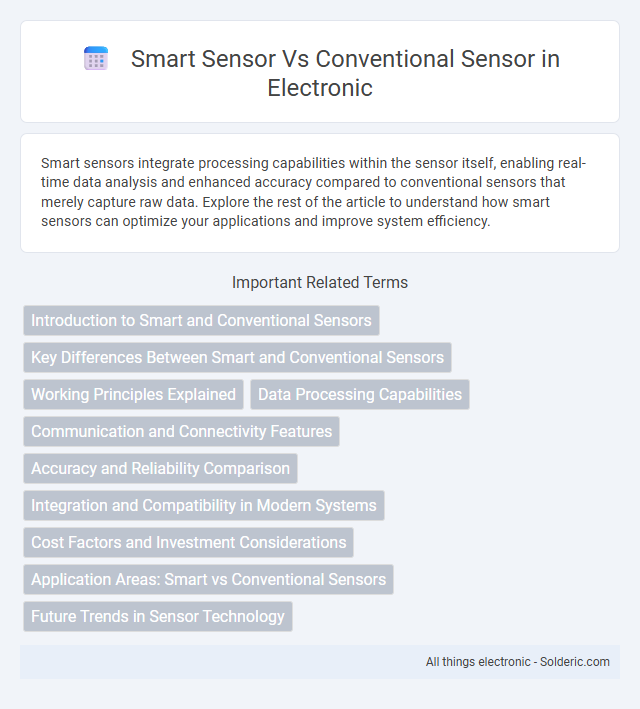Smart sensors integrate processing capabilities within the sensor itself, enabling real-time data analysis and enhanced accuracy compared to conventional sensors that merely capture raw data. Explore the rest of the article to understand how smart sensors can optimize your applications and improve system efficiency.
Comparison Table
| Feature | Smart Sensor | Conventional Sensor |
|---|---|---|
| Definition | Integrated sensor with built-in processing and communication capabilities | Basic sensor measuring physical parameters without processing |
| Data Processing | Onboard signal processing and data analysis | Raw data output requiring external processing |
| Communication | Supports digital communication protocols (I2C, SPI, UART, etc.) | Usually outputs analog signals or simple digital signals |
| Accuracy | Higher accuracy due to integrated calibration | Lower accuracy; relies on external calibration |
| Power Consumption | Generally higher power due to processing units | Lower power usage |
| Cost | Higher initial cost due to complexity | Lower cost, simpler design |
| Applications | IoT devices, automation, robotics, smart environments | Basic measurement tasks, legacy systems |
| Maintenance | Self-diagnostics and calibration reduce maintenance needs | Requires frequent manual calibration and maintenance |
Introduction to Smart and Conventional Sensors
Smart sensors integrate built-in microprocessors that enable data processing, self-calibration, and communication, enhancing functionality beyond conventional sensors, which primarily detect physical changes and output raw signals. Conventional sensors rely on external systems for signal conditioning and interpretation, limiting real-time data analysis and adaptability. Advances in smart sensor technology have revolutionized applications in automation, healthcare, and IoT by providing accurate, real-time insights and reducing the need for complex external hardware.
Key Differences Between Smart and Conventional Sensors
Smart sensors integrate built-in microprocessors that enable data processing, self-calibration, and real-time diagnostics, unlike conventional sensors which only provide raw data output requiring external processing. You benefit from enhanced accuracy, improved signal processing, and greater versatility with smart sensors due to their embedded intelligence and ability to communicate via digital interfaces. Conventional sensors are simpler and often more cost-effective but lack the adaptive features and automation capabilities that define smart sensor technology.
Working Principles Explained
Smart sensors integrate microprocessors to process signals and provide real-time data analysis, enabling advanced functionalities such as self-calibration and diagnostics, unlike conventional sensors that solely convert physical stimuli into electrical signals. Conventional sensors operate based on basic principles like resistance change, capacitance variation, or piezoelectric effects to detect parameters such as temperature, pressure, or motion without embedded computation. Your choice between smart and conventional sensors depends on the complexity of the application and the need for intelligent data processing at the sensor level.
Data Processing Capabilities
Smart sensors integrate data processing capabilities such as filtering, amplification, and digital conversion directly within the device, enabling real-time analysis and decision-making at the sensor level. Conventional sensors primarily capture raw data, requiring external systems to process and interpret the information, which can introduce delays and increase system complexity. By leveraging smart sensor technology, Your applications benefit from faster response times and reduced reliance on centralized processing units.
Communication and Connectivity Features
Smart sensors integrate advanced communication protocols such as IoT connectivity, Wi-Fi, Bluetooth, and Zigbee, enabling real-time data transmission and remote monitoring capabilities that conventional sensors lack. Conventional sensors typically rely on wired connections or simple analog outputs, limiting their ability to interface directly with digital networks or cloud-based platforms. Enhanced connectivity in smart sensors facilitates seamless integration into automated systems, resulting in improved data accuracy and faster decision-making processes.
Accuracy and Reliability Comparison
Smart sensors utilize integrated microprocessors and advanced algorithms to deliver superior accuracy and reliability compared to conventional sensors, which rely solely on basic sensing elements. Their ability to perform real-time data processing and self-calibration minimizes errors caused by environmental factors and component aging. You benefit from enhanced precision and consistent performance, making smart sensors ideal for critical applications requiring dependable measurements.
Integration and Compatibility in Modern Systems
Smart sensors offer seamless integration and superior compatibility with modern digital systems due to embedded microprocessors that enable real-time data processing and communication via standard protocols like I2C, SPI, or UART. Conventional sensors typically rely on analog signals requiring additional external processing units and complex interfacing, limiting compatibility with IoT and automation platforms. By choosing smart sensors, you enhance system scalability and simplify connectivity within today's interconnected industrial and consumer applications.
Cost Factors and Investment Considerations
Smart sensors often require a higher initial investment due to advanced components and integrated processing capabilities, but they reduce long-term operational costs through enhanced accuracy and predictive maintenance. Conventional sensors are generally cheaper upfront but may incur higher expenses over time because of frequent recalibration and limited data integration. Your decision should weigh immediate budget constraints against potential savings and efficiency gains over the sensor's lifecycle.
Application Areas: Smart vs Conventional Sensors
Smart sensors excel in applications requiring real-time data processing and adaptive feedback, such as industrial automation, healthcare monitoring, and autonomous vehicles. Conventional sensors are widely used in basic measurement tasks across sectors like environmental monitoring, household appliances, and automotive systems where simple data acquisition suffices. The integration of embedded microprocessors in smart sensors enables complex analytics and network connectivity, outperforming conventional sensors in dynamic and safety-critical environments.
Future Trends in Sensor Technology
Smart sensors integrate advanced processing capabilities and connectivity, enabling real-time data analysis and remote monitoring, which boost efficiency across industries. Conventional sensors rely on basic data collection with limited processing, often requiring external systems for analysis, leading to slower response times. Future trends emphasize the growth of IoT-enabled smart sensors, enhanced AI-driven analytics, and lower power consumption to foster more autonomous and adaptive sensor networks.
Smart sensor vs conventional sensor Infographic

 solderic.com
solderic.com